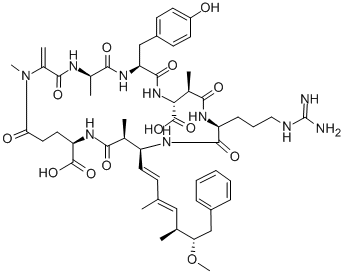Microcystin YR from Microcystis aeruginosa has been used to assess cytotoxicity in neutrophils using DNA fragmentation and cell viability assays and as a reference standard in the quantification of microcystin from water samples.
Microcystin is a potent cyanotoxin produced by the bloom of Microcystis aeruginosa. It is harmful to aquatic animals. It is a heptapeptide and exists as multiple variant forms. pCO2 and nitrogen levels modulate the toxic variants levels. It elicits damage to the liver and other organs.
Microcystin YR inhibits protein phosphatase type 2A and protein phosphatase type 1. Toxicity to undifferentiated cells was seen by inhibition of neutral red uptake, >80% at 100 μM, after 48 h.
